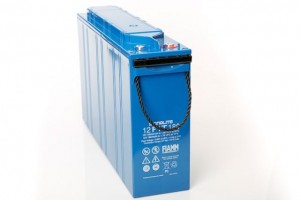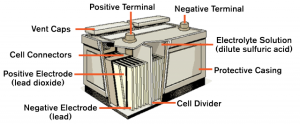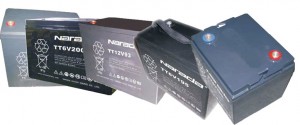A car’s battery is designed to provide a very large amount of current for a short period of time. This surge of current is needed to turn the engine over during starting. Once the engine starts, the alternator provides all the power that the car needs, so a car battery may go through its entire life without ever being drained more than 20 percent of its total capacity. Used in this way, a car battery can last a number of years. To achieve a large amount of current, a car battery uses thin plates in order to increase its surface area. A deep cycle battery is designed to provide a steady amount of current over a long period of time. A deep cycle battery can provide a surge when needed, but nothing like the surge a car battery can. A deep cycle battery is also designed to be deeply discharged over and over again (something that would ruin a car battery very quickly). To accomplish this, a deep cycle battery uses thicker plates. Typically, a deep cycle battery will have two or three times the RC of a car battery, but will deliver one-half or threequarters the CCAs. In addition, a deep cycle battery can withstand several hundred total discharge/recharge cycles, while a car battery is not designed to be totally discharged.
First understand your Power Requirement
One of the most important factors that you need to know before buying an inverter is how much power you need to run your electrical appliances such as your tv, lights, satellite or fridge. This will help you determine what size inverter to buy and how many batteries to bank.
Suppose you want 3 Fans, 3 Tube lights, 1 CFL & 1 television to operate at the time of power failure. Below is the power consumed by these items:
1 Fan – 70 Watts
1 tube light – 60 watts
1 CFL – 25 watts
1 Television – 120 watts
Therefore your total power requirement is ( 3*70 +3*60 + 25 + 120) = 535 watts
Find the VA rating of the inverter you need
It stands for the Volt ampere rating. It is the voltage and current supplied by the inverter to the equipments. If an inverter operates with 100% efficiency, then the power requirement of the electrical items and power supplied by inverter is same. But we all know that 100% or ideal conditions don’t exist in real. Most inverters have the efficiency range from 60 % to 80%. This efficiency is also called power factor of an inverter and is simply the ratio of power required by the appliances to power supplied by an inverter. Power factor of most inverters ranges from 0.6 to 0.8.
Hence Power supplied (or VA rating of inverter) = Power requirement ( power consumed by equipments in watts) / Power factor( efficiency).
Here average value of power factor or efficiency is considered i.e. 0.7
Power of inverter (VA) = 535/0.7 = 765 VA
In the market 800 VA inverters are available. So an inverter with 800 VA will be the right choice for your home.
Know the battery your inverter needs
Battery is the backbone of an inverter system. The performance and life of an inverter largely depend upon the battery quality. The next big question is how long will your batteries last? This is what we call the battery capacity. It is the battery capacity that decides how long your inverter will provide power to your appliances. Battery capacity is measured in AH which stands for Ampere Hours. Basically how many amperes will the battery discharge every hour of use. a 100AH battery with a discharge of 5 amps will last 20 hours.
This is how we determine how many batteries are needed:
Battery capacity = Power requirement (your load in watts) x Duration or runtime ( hours) / Battery Voltage (12v)
Battery Capacity = (535 watts x 3hrs) / 12v = 133 Ah
** Value of Battery voltage is taken 12V
Therefore a battery with a capacity of 130 Ah will work for you.
So if you want to run 3 fans, 3 tube lights , 1 CFL and 1 TV for 3 hours during power failure you would need 800VA inverter and 130 Ah battery.
By understanding this simple calculation you not only save yourself from the misleading information shared by inverter dealers but also help yourself in taking correct decision.
GELLED ELECTROLYTE
Advantages
- Totally maintenance free
- Superior deep cycle life when compared to AGM
- Air transportable
- Spill proof/leak proof
- Minimal corrosion thus physically compatible with sensitive electronic equipment
- Installs upright or on side
- Very low to no gassing (unless overcharged)
- Superior shelf life when compared to Wet Cell
- No recharge current limitation @ 13.8 volts
- Rugged and vibration-resistant
- Very safe at sea with no chlorine gas in bilge (due to sulfuric acid and salt water mixing)
- Most versatile: Starting. Deep Cycle, Stationary
- Lowest cost-per-month (cost / months of life)
- Lowest cost-per-cycle (cost / life cycles)
Disadvantages
- Higher initial cost
- Water cannot be replaced if continually overcharged
- Voltage-regulated chargers must be used
- Charge voltage must be limited to extend life (13.5 to 13.8 volts maximum at 68°F)
—————————————————————————————
(AGM) ABSORBED ELECTROLYTE
Advantages
- Ideal for standby or back-up applications
- Higher charge and discharge currents
- Totally maintenance-free
- Air transportable
- Spill proof/ Leak proof
- Minimal corrosion thus physically compatible with sensitive electronic equipment
- Installs upright or on side
- Lower cost than gel cell batteries
- Very low to no gassing (unless overcharged)
- Excellent for starting and stationary applications
- Superior for shorter duration/higher discharges
Disadvantages
- ½ the cycle life of Gel or flooded Wet Cell in deep cycle applications
- Charge voltage must be limited (14.1 to 14.4 volts maximum at 68°F )
- Voltage-regulated chargers must be used
- Water cannot be replaced if continually overcharged
—————————————————————————————
WET CELL (FLOODED ELECTROLYTE) 
Advantages
- Lowest initial cost
- Water can be added (if accessible)
- Excellent for higher current applications
- Certain designs are good for deep cycle applications
- Replacements readily available
Disadvantages
- Spillable
- Operates upright only
- Emits corrosive Gases and thus cannot be installed near sensitive electronic equipment
- Cannot be installed near sensitive electronic equipment
- Maintenance required (if accessible)
There is not one single battery that is suited for all applications or weather conditions. Instead an evaluation will help determine the battery that is best suited for the site conditions and application. Consult with Caprica Solar to ensure your system’s integrity and the safety of those who operate them.
Gel vs. AGM vs. Wet Cell Batteries
One of the most important decisions when designing a stand-alone power system is deciding the best battery for the application. Gathering information about the site’s maximum summer and lowest winter temperatures, the duration of extreme conditions, accurate load and duty-cycle information, and charge and discharge cycles are all key factors in battery selection.
Failure to make the right decision based on area classifications, power cycle life, maximum environmental temperatures, and maximum low temperatures are all factors that can lead to safety issues, the early death of a battery, and the unexpected failure/loss of control, measurement, communications, or UPS systems. Be sure to consult a specially trained technician to design stand-alone power systems using the following information as a guide.
Gel Cell, Absorbed Glass Mat (AGM), and Wet Cell are various versions of lead acid batteries. The Wet comes in two styles: serviceable, and maintenance free. Gel Cell and the AGM batteries are specialty batteries that typically cost twice as much as a premium Wet Cell battery. However, Gel cell and AGM batteries do not tend to sulfate or degrade as easily as Wet Cell. As a result, there is little chance of a hydrogen gas explosion, or corrosion of electrical components and wiring in close proximity when using these batteries. In most cases AGM batteries will give longer life span and greater cycle life than a Wet Cell battery.
What is the difference between Gel Cell and “(AGM)” Absorbed Electrolyte batteries?
AGM batteries are typically good deep cycle batteries and they deliver their best life performance if recharged before the battery drops below the 50 percent discharge rate. These batteries typically have a shorter life cycle than Gel Cell batteries (as much as ½). They are often best used in applications requiring higher charge and discharge currents such as those in a UPS backup power system.
The recharge voltages of Gel Cells are lower than the other styles of lead acid battery. Gel Cell batteries are best used in very deep cycle application and may last a bit longer in hot weather conditions. The selection of battery chargers with Gel Cell batteries is critical because using an incorrect battery charger with a Gel Cell battery will cause poor performance and premature battery failure.
What is the difference between Gel Cell/AGM and traditional Wet Cell batteries?
Wet Cells contain liquid electrolyte that can spill if tipped or punctured, causing corrosion to affected areas. Therefore, they are not air transportable without special containers. They cannot be shipped via UPS or Parcel Post, and should not be used near sensitive electronic equipment. They can only be installed “upright.”
Can Gel Cells be installed in sealed battery boxes?
NO! Never install any type of battery in a completely sealed container. Although the normal gasses (oxygen and hydrogen) produced in a Gel Cell battery will recombined and not escape, oxygen and hydrogen can escape from the battery in an overcharged condition (as is typical in any type battery).
For safety’s sake, these potentially explosive gasses must be allowed to vent to the atmosphere and must never be trapped in a sealed battery box or tightly enclosed space.
MAINS electricity is scarce and unreliable in Africa, but a solar revolution is afoot.

